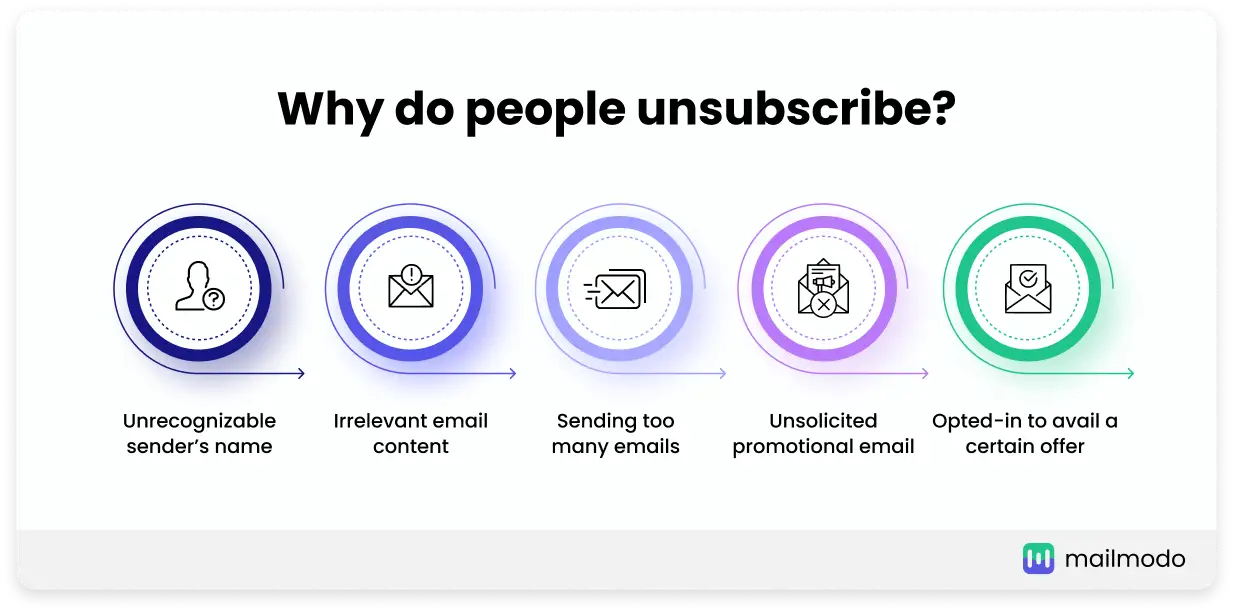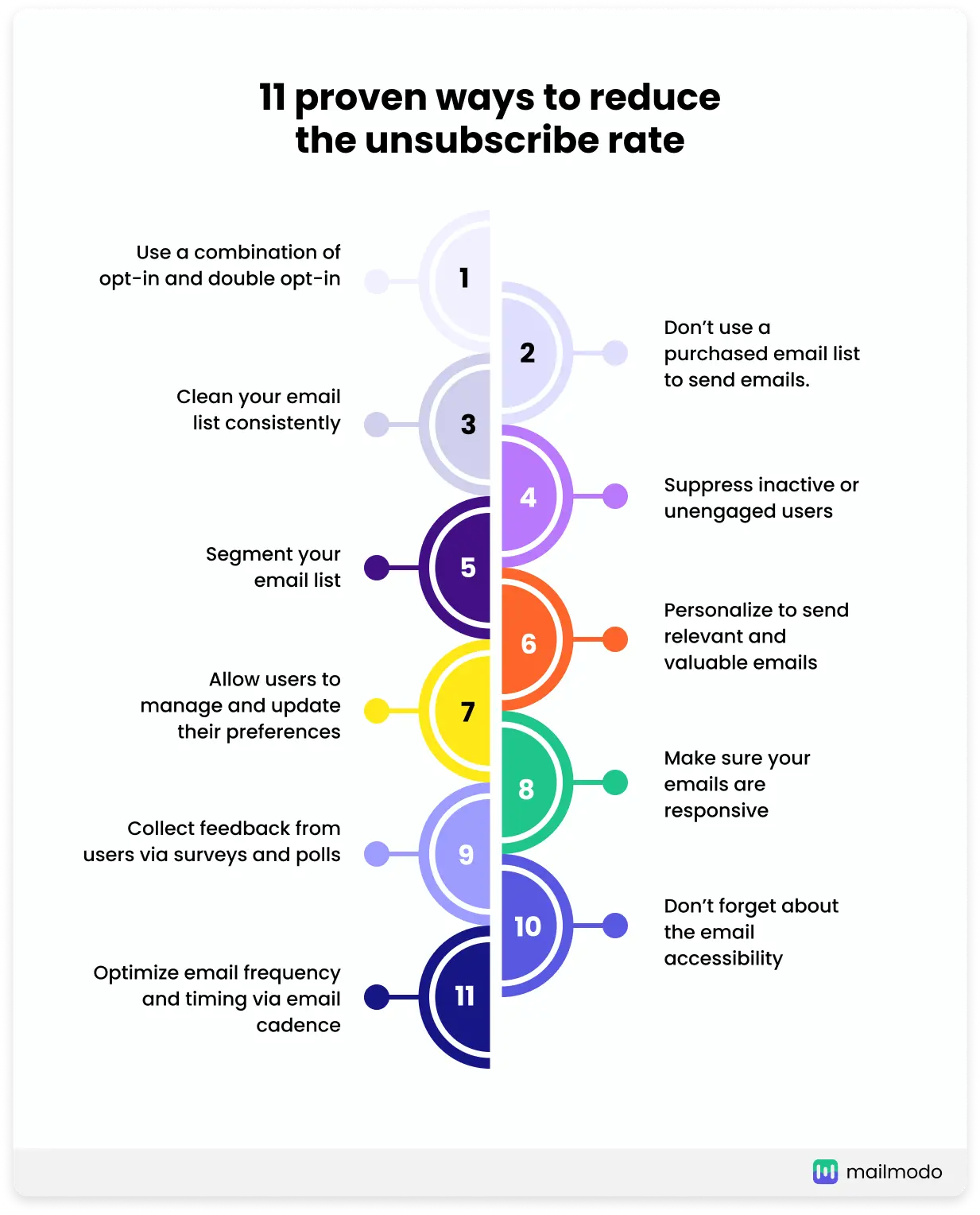The unsubscribe rate is the least talked about metric in email marketing.
But, it is an important metric as if you're not paying attention to it, your spam complaints rate might spike, and deliverability will take a deep dive.
To tackle this issue, we will discuss the reasons behind the email unsubscribe rate and how you can improve it if it falls below the industry average.
Table of contents
11 proven ways to reduce the unsubscribe rate
- 1. Use a combination of opt-in and double opt-in
- 2. Don't use a purchased email list
- 3. Clean your email list periodically
- 4. Suppress inactive or unengaged users
- 5. Segment your email list
- 6. Personalize to send relevant and valuable emails
- 7. Allow users to manage and update their preferences
- 8. Collect feedback from users via surveys and polls
- 9 Make sure your emails are responsive
- 10. Don't forget about the email accessibility
- 11. Optimize email frequency and timing via email cadence
What is the email unsubscribe rate?
The email unsubscribe rate is the percentage of people who opt out of a certain email campaign from the total number of emails delivered. There can be several reasons behind unsubscribing, including irrelevant content, unsolicited emails, loss of interest, changes in preferences, etc.
It's among the important email metrics to track as it will help remove people who don't want to receive emails from you. Hence, keeping your email deliverability intact.
How to calculate the unsubscribe rate?
Unsubscribe rate = Number of users unsubscribed/Number of emails delivered X 100
For example, if your Labor day holiday campaign gets 9000 emails delivered to the recipient's inbox and 100 people opt-out of receiving such emails, then the email unsubscribe rate will be 10%
It means 10% of your subscribers aren't interested in receiving such emails. You should remove these people immediately from your email list to avoid sending them any future campaigns.
Now, a question you might ask: Is 10% a good or bad unsubscribe rate?
The answer is it depends on various factors:
The industry you belong to
Email list size
Type of email campaigns
The region you do business in
But, studies conducted by big names in the email marketing world reveal unsubscribe rate benchmarks for different industries and regions. You can use these industry benchmarks as a standard to measure your campaign's unsubscribe rate and adjust your strategy.
Let's discuss these studies.
What is a good unsubscribe rate?
Here what's the research says about a good email unsubscribe rate:
Mailchimp's study of its customers ranging from one-person startups to Fortune 500 companies reveals the industry average email unsubscribe rate at 0.26%.
Benchmark's study of nearly 8255 users across 15 industries and 22 regions gives the following data:
- The industry average unsubscribe rate is 0.19%.
- The average unsubscribe rate for different regions also stands at 0.19%.
GetResponse has got some great insights about the average unsubscribe rate:
| - | Average unsubscriberate |
|---|---|
| Based on the country and industry | 0.12%. |
| Based on email type | Newsletter: 0.11% Triggered emails: 0.43% Autoresponders: 0.21% Welcome emails: 1.19% |
From Get response's statistics, it's evident that the unsubscribe rate is higher for welcome emails comparatively. Stephani Griffith, Founder of emailpreview.io, shares her insights,
Welcome series unsubscribe rates tend to be very high. If someone only signed up for a discount or decided they were no longer interested in the content, this is the first chance they have to cancel/Opt-out
From these statistics, we can assume that an email unsubscribe rate of 1-2% can be considered good or acceptable.
If your unsubscribe rate is more than the industry average, then your first step should be understanding the reason behind it and working on improving the rate.
Five major reasons behind why people unsubscribe
Based on our understanding, some of the common reason behind people unsubscribing is as follow:

- Unrecognizable sender's name
54.9% of respondents in Pathwire's survey said they're likely to unsubscribe if they get an email from someone they don't know.
- Irrelevant email content
No one likes to see their already crowded inbox filled with irrelevant emails. That's why 53.8% of people say it is one of their reasons for opting out.
- Unsolicited promotional email
Consent to send emails is a prerequisite to operating in email marketing. If you send promotional emails without the recipient's consent, 57.1% of them will unsubscribe or mark a message as spam.
- Sending too many emails
One of the easiest ways to annoy subscribers is by bombarding them with frequent emails. It can be easy to think that you're sending the right number of emails, but your subscriber can feel overwhelmed and unsubscribe.
- Opted-in to avail of a certain offer
Sometimes, unsubscribing has nothing to do with your email content or frequency. If you are running special offers and ask people to sign-up to avail of it, they might subscribe. But, as soon as they get the offer, they will unsubscribe.
11 proven ways to reduce the unsubscribe rate
Despite a good or bad unsubscribe rate, it is always better to remain on the safe side. The fewer unsubscribed, the better for your organization.
Here we will give you 11 ways that you can use to reduce unsubscribes:

1. Use a combination of opt-in and double opt-in
How would you feel if someone entered your house without your permission? You probably won't like it. Your home is your personal space, and similarly, the user's inbox is very personal to them.
So, you should ask their permission before entering that space or remember that big unsubscribe link that users will click!
How do you do that?
Use opt-in and double opt-in to confirm that users want to hear from you.
2. Don't use a purchased email list
A purchased email list is likely to hurt your email marketing performance in many ways and users' unsubscribing from your emails is one of those damages. Because users on a purchased email list don't know you, and who likes to hear from a random brand they never heard of?
Besides, you can become an annoying brand as emails will not be relevant to the users. It will impact your email open rates and deliverability rate. So, avoid sending emails to the purchased email address.
3. Clean your email list periodically
Collecting the email address to build an email list isn't enough.
You must clean your email list periodically by removing users who have opted out, getting more on board, and updating or correcting existing email addresses. It will help you send emails to only interested audiences and keep your domain reputation intact.
4. Suppress inactive or unengaged users
You should take a step back if you still send emails to unengaged or inactive users.
Why?
Because those users probably don't want to hear from you, sending them an email is like pushing them towards that unsubscribe link. To avoid this, suppress these email addresses and never send them emails again.
Don't know how to create a suppression list? Read our guide on How to create a suppression list.
5. Segment your email list
Segmenting your email list will help you send relevant content to users interested in those emails.
For example, it is better to tell users that you launched a new product update that engages with your product instead of broadcasting it to every user. This way, you will get higher engagement and lesser unsubscribes.
6. Personalize to send relevant and valuable emails
Personalization is like the cherry on top of segmentation. Segmenting users and then targeting them with personalized emails is a strategy that is becoming a must-have in your marketing plan.
When you send targeted emails and offer quality content, users engage more, and it helps build trust. Such engagement and trust help in reducing unsubscribes.
7. Allow users to manage and update their preferences
Giving users an option to manage or update their preferences is an effective way to reduce email unsubscribes.
How?
For instance, Mailmodo offers users to adjust what kind of email they want to receive from them. As a result, it gives brands better insight into what users want and helps them send the most relevant emails.
8. Collect feedback from users via surveys and polls
Another way is to ask your users for feedback via surveys and polls. It will give unfiltered insights into their thoughts about your organization, emails, and how you can improve your future campaigns.
For example, you can create polls and interactive AMP surveys to get a higher response from your users. Then you can use this data to create targeted and relevant content for your users.
Here's an example of using AMP email surveys to collect feedback:
9 Make sure your emails are responsive
Your email lists consist of users who use different devices - mobiles, desktops, and tablets, to access and read your emails. A responsive email design enhances user experience and also increases engagement.
To make email responsive, you must first know which devices subscribers use and run a/b tests to ensure that emails are delivered the way you intended.
10. Don't forget about the email accessibility
According to the WHO, over one billion people live with some form of disability. It means they can't access your emails like other users. And if those emails are not designed for them, they will get annoyed and unsubscribe.
So, you must ensure that you create emails accessible to every user despite their disabilities.
Here are a few tips to make emails accessible:
Use legible typography.
Add descriptive alt text in case images don't render correctly.
Color contrast should be at least 4.5:1 so that users with visual impairments can read and understand.
Use role=" presentation" attribute on all table elements.
You can read our guide for an in-depth understanding of ensuring email accessibility.
11. Optimize email frequency and timing via email cadence
One of the top reasons for users' unsubscriptions is getting too frequent emails that seem irrelevant to them. So, to avoid that, you must honor the user's preferences.
Send them only that email if they signed up for your weekly newsletter. If they sign up for a promotional email daily, ensure you send them only those emails.
Besides, sending emails at the right time will also help you target users when they are actively checking their inboxes.
Way forward
Keeping your audience engaged is tough, and you can't keep each of them happy every time. That's one thing we want you to understand.
Second, users are still unsubscribing even after your hard work and efforts. So, it's good to let them go! Because reaching out to them with email campaigns they clearly no longer want to receive is likely to put you into a spam folder, affecting your domain reputation.
So, it's wise to keep those users happy who are interested in your brand by sending relevant email campaigns.


